How To Repair F-150 Air Vent
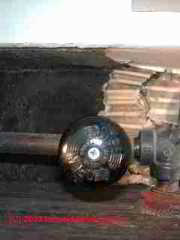 Radiator Valves & Vent Controls
Radiator Valves & Vent Controls
Hot H2o & Steam Heat Control Guide
- POST a QUESTION or Comment well-nigh using, adjusting, & repairing radiator control valves and vents for both hot water and steam oestrus systems
InspectAPedia tolerates no conflicts of interest. We take no relationship with advertisers, products, or services discussed at this website.
Radiator valve inspection & troubleshooting:
In this article series we explicate the use, adjustment, diagnosis & repair of hot water or steam heating radiator valves & steam vents to command oestrus output from individual radiators. What to practise about hot h2o or steam radiator valves or vents that are stuck open or closed.
Which way to plough the radiator valve to open or close information technology. How to replace a leaky or stuck heating radiator valve. Install a thermostatically operated radiator valve.
We likewise provide an Commodity Index for this topic, or you can attempt the page top or bottom SEARCH BOX as a quick way to observe data you lot need.
Guide to Using, Adjusting, Diagnosing & Fixing or Replacing Hot Water or Steam Radiator Control Valves & Vents
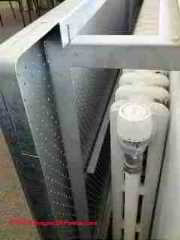
Hot water heating radiator or convector troubleshooting, repair, or installation articles in this series include the post-obit:
Article Series Contents
- AIR-BOUND HEATING SYSTEMS - home
- AIR BLEEDER VALVES
- COLD HOT WATER RADIATOR or BASEBOARD
- COLD STEAM HEAT RADIATORS
- RADIATOR VALVES & Oestrus CONTROLS
- ADJUST LEVEL of HEAT - How to Adjust or Command the Level of Estrus From Radiators
- Automatic RADIATOR VALVES - Automated or Thermostatically Controlled Radiator Valves
- RADIATOR CONTROL VALVES on CONVECTOR HEATERS
- RADIATOR VALVES MANUAL - Which manner to turn the radiator valve
- RADIATOR VALVE STUCK or BROKEN REPAIR - how to repair or supercede radiator valves
- RADIATOR VALVES HOT WATER vs STEAM - what'south the difference?
- STEAM HEAT VENT CHOICES & INSTALLATION - Adaptable or Thermostatically Controlled
- STEAM VENTS THERMOSTATICALLY CONTROLLED - Used to control steam radiators
Traditional "Manual" Radiator Valves
Radiator valves are opened to allow hot water or steam to enter and heat a radiator, or closed to turn off or reduce heat output from the radiator. By "manual" radiator valve we mean that you lot accept to turn the valve open or shut yourself. We discuss automatic (thermostatically controlled radiator valves and other radiator controls below.
At above left is a top-fed ii pipe steam radiator at Google Headquarters in New York City.
If your heating organization radiators won't get hot, for hot h2o radiators or convector heat,
see Cold HOT H2o BASEBOARD / RADIATOR;
For cold steam heat radiators
meet COLD STEAM Rut RADIATORS for help in diagnosing the problem.
If your heat is provided by baseboards there will not usually be individual shutoff valves at those devices, but if your system uses 1 circulator and provides multiple heating zones (and thermostats) there will be zone control valves (usually nigh the boiler) that are opened or closed by the room thermostat(due south).
Cold heating baseboards are discussed
at AIRBOUND Rut Organization REPAIR by WATER FEED VALVE.
Which Way to Turn the Radiator Valve
 If your heat is provided by private hot water radiators or convector units, usually there is a control valve at each radiator or convector. Make certain that the control valve at the heating radiator is "open up" or "on". Normally turning a radiator valve "clockwise" or "down" closes the valve (turns the rut
If your heat is provided by private hot water radiators or convector units, usually there is a control valve at each radiator or convector. Make certain that the control valve at the heating radiator is "open up" or "on". Normally turning a radiator valve "clockwise" or "down" closes the valve (turns the rut
At Cold HOT Water BASEBOARD / RADIATOR nosotros include links to additional detailed articles that will assist you right a trouble with heating baseboards or radiators that are not working:
Check the radiator command valve: If a radiator is non getting hot: (steam or hot h2o) showtime see if the valve that controls it has been turned off. Endeavour turning the valve counter-clockwise to come across if information technology will open.
In our photograph (left), the heating convector control valve was found at floor-level under the heating convector. The "open" and "shut" directions for this "radiator valve" were nicely marked past the manufacturer (click to enlarge the photo).
If the radiator valve does not turn in that direction, try turning it in the other direction (clockwise or "closed") to see if the radiator valve is stuck. Y'all may also discover the same command valve at heating convectors (just non usually at heating baseboards).
While people sometimes turn off radiators in an united nations-used portion of a edifice nosotros unremarkably find that about radiator valves have been left in the "on" position - in fact turning off a hot radiator in some building areas could lead to its freezing and bully.
Steam radiators, on the other hand, tin usually be turned-off with impunity since steam radiators do non normally contain water in its liquid course. [That's truthful at to the lowest degree so long as condensate has not get trapped within of the steam radiator.]
How to Fix Stuck Heating Radiator Valves
Spotter out: don't use excessive force to try to turn a "stuck" radiator valve.
Starting time, you lot may be trying to open a valve that is already in its fully-open position. Second, the valve may actually be jammed.
Excessive force can pause the valve or even cause a leak. If the valve won't turn at all counter-clockwise towards "open", try turning it the other way - clockwise, towards "closed". If the valve now turns you lot'll know it was already in its open position.
Broken Radiator Valves
Watch out: fifty-fifty if the radiator valve appears to be "open up" - that is, turned fully counter-clockwise, if the radiator valve stem is broken internally you may exist simply turning the knob but the valve may exist staying closed within.
If your radiator valve turns too easily or if it does not appear to enhance (opening) or lower (endmost) when turning, and specially if turning the valve makes no difference in the behavior of the radiator, the valve stem may exist broken. (Starting time check for air bound radiators or if your heating system uses steam, bank check for a steam vent that is not opening.)
Usually while turning a radiator valve to from "closed" to "open" position, if y'all look closely at the valve stem - the metal rod or shaft extending below the knob yous are holding, and extending into the trunk of the valve itself - you'll come across that as you "open up" the valve the stem gets "longer" and often a less-oxidized, shiner office of the valve will become exposed equally it moves up from having been within the valve body.
That's a great way to convince yourself that aye, the valve is probably opening internally too, you're not just turning the knob. If the valve body has broken loose from the valve stem, that'southward an internal problem you can't see, just turning the radiator valve knob, fifty-fifty if information technology rotates, will not open a broken, stuck, frozen valve.
If only some of your hot water radiators, hot water heating convector units, or hot water baseboard heating sections are not getting hot and the radiator valve is open up,
see AIRBOUND Oestrus System REPAIR past WATER FEED VALVE (hot water heat) or if a steam radiator valve is open but the radiator is still cold, the steam vent may not be working.
See RADIATOR STEAM VENTS and
also STEAM HEATING SYSTEMS for details.
Types of Radiator Valves: Hot H2o vs Steam
Hot Water Heat Radiator Valves
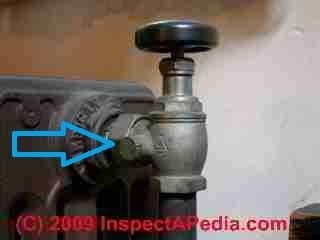
In our photo at left you tin encounter not only the radiator control valve, but lots more than information:
This radiator is beingness fed from the meridian. We know that this must be either a hot h2o radiator or a two piping steam oestrus radiator.
Now look closely at that air bleeder connector on the side of the radiator valve.
From this detail we can conclude that this is a hot water heating system, not a steam heat system
Hot h2o tin enter a hot water (hydronic) heating radiator at the radiator height or bottom. Hot water radiators may have an air bleeder valve but never a steam vent valve.
Steam can enter a steam heating radiator at the radiator meridian too (well-nigh but possibly not all two pipage steam heat systems) or also at the radiator bottom (1 pipe steam heat systems).
Steam Radiator Control Valves
 If your heating system uses steam radiators or steam convectors
If your heating system uses steam radiators or steam convectors
meet Cold STEAM HEAT RADIATORS for help in diagnosing and fixing steam radiators that won't go hot. Excerpts from that article are establish below.
First check the radiator valve. It'south standard to ask first "is the radiator valve turned on or "open up" (fully counter-clockwise)?
Simply other problems can cause a steam estrus radiator to stay cold when y'all want estrus.
If a steam radiator valve is open just the radiator is still common cold, the steam vent may not exist working.
Our photo (in a higher place right) shows a typical steam radiator vent.
Run into STEAM RADIATOR Pipe CONNECTIONS for an explanation of different types of steam piping and steam-radiator pipage connections.
Also see STEAM VENTS and
also STEAM HEATING SYSTEMS - dwelling house
In-Line Hydronic Estrus Command Valves, Pneumatic or Vacuum or Electrical
Question: place this hot water heating command valve
2020/xi/24 Kristina said:
How-do-you-do, Could someone assist me identify what kind of valve this is?
It is role of a 1957 hydronic heating system. It is in ane of the bottom kitchen cupboards in the basement apartment of a triplex.

The metal wire coming out of the top is continued to a knob farther downwards on a baseboard heater that doesn't seem to piece of work in adjusting the temperature.
This Q&A were posted originally at CHECK VALVES, HEATING Organisation
Moderator reply:
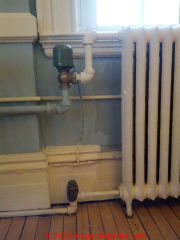 Shown here: a pneumatic or vacuum-operated steam radiator control valve.
Shown here: a pneumatic or vacuum-operated steam radiator control valve.
Kristina
I think that is either an electric (low voltage) OR a pneumatically-controlled (air-operated or in some models, vacuum-operated) steam valve (or hot h2o control) that was connected to a room thermostat or other temperature sensor.
Is information technology possible that your building's heat was originally a steam heating organisation later converted to forced hot h2o ? If so this control could exist a left-over.
Wait closely: is that metallic "wire" coming out of the peak of the valve really a wire or is it a rigid copper tube?
[Click to enlarge any prototype]
Both types of controls accept been used on both hydronic (hot water) and on steam heating systems (wires and pneumatic or copper tubing).
If my approximate is right or "sort-of" right, the control in your photograph is a cousin to the pneumatic/vacuum operated steam command shown in my photograph (above) of a steam radiator installed in Rockefeller Hall on the Vassar College campus in Poughkeepsie NY.
If your heater control no longer responds the valve itself may be jammed (in which case information technology will need to exist removed entirely or replaced peradventure with a zone valve) or the thermostat or wire decision-making it needs to exist constitute and repaired or replaced.
Below we show the Davis patented air valve, one of the primeval air-controlled valve patents that give insight into the history of this device.
- Davis, George Thousand., AIR VALVE [PDF] U.S. Patent No. 404,963 issued June 11, 1990.
Excerpt:
This invention relates more especially to the course of air-valves used on radiators in the system of steam-heating for the purpose of allowing the air to escape and to trap the steam. The valve may exist set to act automatically or be adjusted by hand and Worked on the expansion principle.
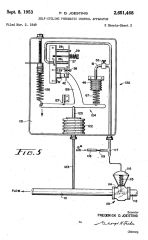
Above is an case of the blazon of thermostsat that operated pneumatic steam oestrus control valves described past Joestinggn'due south 1953 patent. .
- Joesting, Frederick D. TEMPERATURE RESPONSIVE Control APPARATUS [PDF] U.Southward. Patent ii,564,222, issued August 14, 1951.
- Joesting, Frederick D. Cocky-CYCLING PNEUMATIC Command APPARATUS [PDF] U.S. Patent 2,651,468, issued September 8, 1953.
Subconscious Manual Radiator Control Valves on Heating Convectors
On a heating convector unit there is usually an private valve that lets the unit exist turned downward or off - only as our photo (left) shows, the valve can be a picayune harder to spot.
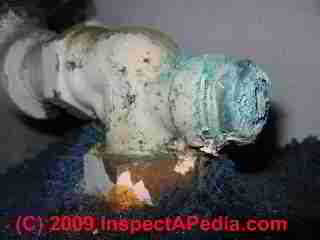 Unlike a radiator valve, a heating convector control valve may be subconscious by the convector's steel embrace, or it may be little and hard to recognize as we show here.
Unlike a radiator valve, a heating convector control valve may be subconscious by the convector's steel embrace, or it may be little and hard to recognize as we show here.
This valve, if it's not jammed by corrosion, is operated by a spiral driver; it may exist possible to get this valve working by gently loosening the lock-nut then turning the control screw with a flat-bladed screwdriver.
Practise not have apart this valve while the heating system is on and hot - yous risk getting sprayed with hot water or you may showtime a leak that'south difficult to stop without making a mess and having to shut down the whole heating organisation.
Trouble getting the one-time corroded air bleeder valve out? Or problem removing a cast iron or steel plug on a radiator where you want to install an air bleeder valve?
Come across RADIATOR PLUG REMOVAL for a suggested procedure as well as for steps to recover your radiator if the vent mounting pigsty threads are badly corroded or stripped.
How to Adapt or Control the Level of Heat From Radiators
Manually Setting the Radiator Valve
On hot water heating systems and two-pipage steam radiator heating systems you tin adjust the radiator valve to:
- Fully closed radiator valve - no heat is wanted from that radiator, but
Watch out: if you completely turn off heat to a hot water radiator in an area exposed to freezing the radiator is likely to freeze, break, and be ruined. - Partly closed radiator valve to call for less heat at an individual radiator - this setting can be used for both hot water heat and for ii-pipe steam heat systems.
On 1-pipe steam oestrus systems the radiator valve is normally fully open up (for the radiator to operate properly) or fully shut (no oestrus); you may notice that some ane-pipe steam heating system radiators will not work properly if the valve is left "in between" these positions.
- Fully open radiator valve - to telephone call for as much estrus as possible from the radiator. For ane pipage steam heat systems, if yous want heat employ this position.
If your hot water radiator is too hot or the room is as well hot, you can partially-shut the radiator valve.
If your hot water radiator is too cold, exist sure that the valve is open and that the radiator is not air bound.
Details are at Cold HOT Water BASEBOARD / RADIATOR
If your steam radiator is too cold be sure that its supply valve is open. If it's a one pipe steam heat system (only one piping comes to each radiator), be sure that the steam vent is working (you should hear it hissing when steam is ascent in the system).
Details are at COLD STEAM HEAT RADIATORS.
If you lot steam radiator is besides hot in a ii-pipe steam system, co-ordinate to the U.Southward. DOE,
In two-pipe systems, older steam traps often stick in either the open up or closed position, throwing off the residue in the system
. If you lot seem to have problems with some radiators providing too much oestrus and others providing besides little, this might be the cause. The best arroyo is ofttimes to simply replace all the steam traps in the arrangement.
If your steam heating organization pipes are noisy
see BANGING HEATING PIPES RADIATORS wHere we explain steam condensate return issues that can cause banging clanging pipes.
In that location are additional methods for automatically controlling the heat output from private heating radiators, for both steam and hot water heat: thermostatically controlled radiator valves and adjustable or thermostatically controlled steam vents. Nosotros discuss these controls beginning
at AUTOMATIC or Thermostatically Controlled Radiator Valves - TRVs.
Reader Question: how to turn off united nations-wanted heat at a baseboard or radiator
 12/31/2014 Margaret said:
12/31/2014 Margaret said:
My hubby and I just bought a 1948 built house and we retrieve it has all original heaters. ii rooms accept the stand up upward mode cast iron radiators.
Our kitchen, dining, and chamber have what nosotros think are cast iron baseboard mode heaters. They look a lot like, only are not exactly, the ones pictured here.
[Click to enlarge any image]
All of the in a higher place-mentioned rooms are all on the aforementioned heating zone. My question is, how exercise I shut off heat to merely ane of the rooms? I'd like to completely shut off the heat to my chamber simply. Tin can I safely do this without shutting off the oestrus to the other rooms?
How do I observe the valve to shut this room off?
At this indicate the bedroom is our biggest waste material of oestrus every bit we have to continue a window open up in there to keep information technology from being insufferably hot, while the other rooms in that zone are nonetheless quite chilly. We have the thermostat gear up down to 50.
Please help!
- Above: an example of cast-atomic number 26 heating baseboard provided past Baseray and used for hot water or steam heating. This production is available from U.S. Boiler - see usboiler.cyberspace.
Reply: comparing baseboards & radiators: which ones have shut-off valves?
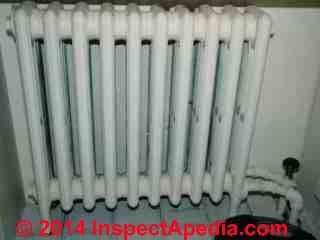 Margo
Margo
You can shut off heat to individual heating radiators such as the cast iron radiator shown at left past closing the individual radiator valve or by installing a thermostatically operated radiator valve such every bit those nosotros illustrate just below.
But your "radiators", if the photograph you refer-to at in a higher place-left is correct, is a segment of bandage iron baseboard. I know the terms are confusing only "baseboard" is generally a horizontal heating chemical element placed (usually) close to the flooring.
Three cases of heating baseboard department control
1. Heating baseboard sections piped in series in 1 loop of hot h2o piping: In the well-nigh common heating baseboard design 1 cannot close off an individual department of baseboard type "radiator" because information technology is piped in series with the rest of that heating zone.
Cut off that baseboard by installing a shutoff valve would stop hot heating water from passing on to other baseboard sections in that zone. Instead you'd have to shut off all of the heat that shares that hot water piping loop.
If your baseboard heat was installed every bit an individual heating zone serving the rooms you name, information technology is probably operating as a heating zone, controlled by a thermostat and zone valve.
See ZONE VALVES, HEATING.
Y'all'd have to have a plumber change the heating system pipage to create private zones - technically possible merely, depending on the ease of access to piping below the rooms involved, possibly rather expensive.
2. Heating baseboard installed to supervene upon older radiators: If the cast iron baseboard heating sections were added to supervene upon older stand-up radiators such as the heating device we show at left, then possibly the piping included a close-off valve at the inlet finish of the baseboard department or in the basement or ceiling below that location.
3. Heating baseboards piped in parallel: Rarely we find sections of heating baseboard piped in parallel. In that case private sections of baseboard might have a shut-off valve installed at the inlet end of the baseboard. Only as it's rare I dubiety that you'll find a shut-off valve for your heating baseboard.
Automatic or Thermostatically Controlled Radiator Valves - TRVs
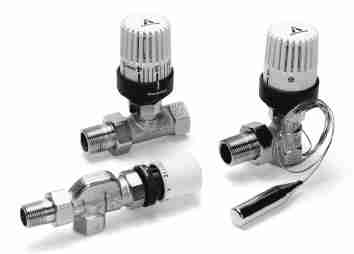
The radiator command valve opens or shuts to let hot water or steam to enter and heat the radiator. An automatic or thermostatically controlled radiator valve allows you to set the desired room temperature.
The automatic hot h2o or steam radiator valve, thermostatically controlled, will automagically open up or close to attempt to command room temperature to the desired level.
Keep in mind that with any heat control installed right at the radiator, the control will be sensing temperature in that location, not across the room, then some experimenting to observe the best setting will be needed.
Armstrong Corp. [image] provides the RV-4 1-Pipe Steam Radiator Valve that operates as a room thermostat suitable for residential low-pressure steam heating systems. Past installing a thermostatically controlled steam vent at each radiator, every radiator can exist controlled or ready to the desired temperature.
There is a central advantage of thermostatically operated steam vents over swapping out the actual radiator control valve for a thermostatically controlled radiator valve, that is, they are easier and less confusing to control.
The original steam vent is simply unscrewed and the new thermostatically controllable steam vent is screwed in at the aforementioned location.
Spotter out: it'southward safer to install or change steam heating system parts when the organisation is not calling for estrus and when the steam boiler and radiators are common cold. Don't be fooled. If your heating organisation is on and the steam boiler is hot, unscrewing the steam vent on a "cold" steam radiator will allow steam to rise into the radiator (forcing air out of the steam vent opening) and you could be seriously burned by rising steam.
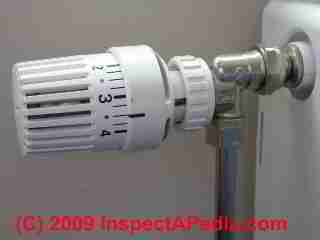
Replacing Manual Radiator Valves with Thermostatically Controlled Radiator Valves
If you lot take to replace the control valve on a hot water or steam radiator or convector unit, consider installing a new valve that incorporates a thermostat as well.
Several companies provide thermostatically-controlled radiator valves including Armstrong, Danfoss, Hoffman Specialty, Jacobus (Maid'O'Mist) and others. The automatic radiator valve shown at left was observed on a typical modernistic European installation in Molde, Norway.
This (more expensive) radiator control valve lets you care for each individual radiator equally a "heating zone".
Every bit long as the room thermostat is calling for heat, each radiator can be regulated automatically when a thermostatic radiator valve (TRV) is installed..
References, Sources, Installation Manuals for Thermostatically-controlled Radiator Valves
- Danfoss ABNM RA-2000 valve is for use on hot h2o & steam systems.
- Danfoss ABRA RA2000 valve are used on some hot h2o and steam heating systems.
- DANFOSS: RA-N Radiator Valves with Integrated Presetting and Self-Sealing Tailpiece [PDF] data specifications and features, retrieved 2022/12/12 original source: http://heating.danfoss.com/PCMPDF/VDSXL202_RA_N_selfseal_teamc.pdf
- DANFOSS VHS valve for parallel and baseconnection radiators, with integral pre-setting and shut-off/drain device [PDF] - data specifications, command valve for modernistic base of operations connexion
radiators, likewise as for universal or bathroom radiators with connection distances of 50mm betwixt flow and return.Contact Danfoss: Danfoss A/S Hårupvænget xi Hårup DK-8600 Silkeborg Telefon: +45 86 80 36 66 Website: http://heating.danfoss.com/
Boysen, Herman, Kv: What, WHy, How, Whence?, [PDF] Danfoss, (2011) retrieved 2022/12/12 original source: http://heating.danfoss.com/PCMPDF/VFHBG202_kv.pdf
- DANFOSS RA2000 RADIATOR VALVE INSTALLATION INSTRUCTIONS [PDF] usable on hot water & ii-pipe steam heating systems.
Excerpts from production literature: RA 2000 Thermostatic radiator valves regulate the flow of hot water of hot h2o or steam through free-continuing radiators, baseboards or convectors in hot water and two-pipe low pressure steam systems.
RA 2000 Thermostatic Radiator Valves regulate the flow of hot water or low pressure level steam through free-standing radiators, baseboards, or convectors in hot h2o and two-pipe steam systems.
The Danfoss 013G8250 is the RA2000 Thermostatic Radiator Valve Operator with a valve mounted dial and a born sensor. The RA 2000 thermostatic operator consists of a saturated vapor charged bellows and a setting dial. The dial is set to the position equal to the desired temperature. When the ambient temperature lowers, the pressure from the bellows will reduce, allowing the valve to open. A rise of temperature increases the pressure level in the bellows endmost the valve. The balanced pressures betwixt the aligning jump and the bellows ensure a smooth and modulating functioning of the valve.
- DANFOSS ZONE VALVES & RADIATOR VALVES SELECTION Nautical chart [PDF]
- DRAYTON TRV4 THERMOSTATIC RADIATOR VALVE Transmission [PDF] Drayton Controls, U.Yard., Sales Tel: +44 0 845 130 5522, E-mail: client.care@invensys.com retrieved 2022/12/12 original source: http://world wide web.draytoncontrols.co.uk/sites/default/files/TRV4%20%28U.%26I.%20Guide%29.pdf
- DRAYTON TRV5 THERMOSTATIC RADIATOR VALVE Itemize [PDF] op. cit. original source: file:///Users/danielfriedman/Downloads/pa_457823.pdf
- Elgato Eve Thermo App-Enabled Thermostatic Radiator Valve (Appel HomeKit / Bluetooth) - may not be bachelor
- HONEYWELL BRAUKMANN V2040HSL10 INSTALLATION INSTRUCTIONS [PDF]V-2000 series radiator valve (replaces the Honeywell V100 Series valve series), usable on 1-pipe steam heating organisation radiators and on hydronic heating systems. Note: this is a one/8" 1 pipage steam radiator valve.
Excerpt: One-Piping Steam Thermostatic Radiator Valves - Let automated temperature command in one-pipage steam or hot h2o systems for costless standing radiators, convectors and other heating units with standard capacity requirements. Provide condolement and energy savings.
...
Adjustable balancing cartridge design made from resilient material (EPDM), ensures tight shut-off on steam and hot h2o systems. - HONEYWELL T104 Controls & V110 Valve Body THERMOSTATIC RADIATOR VALVES [PDF] (1990) Honeywell Thermostatic Radiator Valves including the Honeywell Braukmann series direct and angled radiator valves are sold in a range of models and capacities. Retrieved 2022/12/12 original source: https://client.honeywell.com/resources/techlit/TechLitDocuments/62-0000s/62-3004.pdf
- HONEYWELL T104A Thermostatic Command [PDF] (1994) Retrieved 2022/12/12 original source: https://forwardthinking.honeywell.com/related_links/water/thermostatic_radiator_valve/install/62_3046.pdf
- SALUS PH60 Programmable Thermostatic Radiator Valve
Automatic or Thermostatically Controlled Steam Vents
This topic has been moved and consolidated at STEAM VENTS - topic dwelling, where nosotros discuss other steam vent problems such as spitting water, clogging, steam valves that do not open or close when they should, etc.
At STEAM VENT TYPES, SELECTION we identify the dissimilar types of steam vents use on one pipage and 2 pipe steam systems.
Choosing & Installing Adaptable or Thermostatically Controlled Steam Vents to Control Steam Estrus
This text has moved to GUIDE TO CHOOSING & INSTALLING STEAM VENTS.
Watch out: If the radiator continually makes noises (whistling or wheezing) at the steam vent, there is a problem that needs to exist fixed: a bad steam vent, steam pipage problem, steam pressure set also high, or boiler oversized for the heating distribution system.
Scout out: to be certain your steam heating organization and its controls are properly adjusted excessive steam pressure level can be dangerous.
Reader Q&A - as well see the FAQs serial linked-to below
I suspect that radiator is air jump. If there is an air bleeder valve on the rad you'd open up it advisedly, to let out air; the moment you see water you'd close information technology.
Sentinel out: if you break off or damage the air bleeder you'll have to close downwards the rad or the heating arrangement until information technology's repaired.
The pipe leading TO this one radiator does not go hot. As well the pipe leading FROM this aforementioned radiator also does non go hot. As a result this one radiator does not get hot. Funny affair is that the larger pipes to which these pipes are connected are blazing hot.
My heating system uses hot water.
Ian
When a radiator isn't getting hot just the air bleeder releases no air (and assuming the air bleeder is properly located high on the radiator where it belongs) it'south still possible that the supplying hydronic (hot water heat) pipage system is partially air-spring somewhere in the circuit. That would be no surprise on a new heating system.
Ask your heating installers to render to force-drain air from all of the piping.
Details are at Cold HOT H2o RADIATOR or BASEBOARD https://inspectapedia.com/heat/Cold_Radiator_Repair.php
Take home central heating system installed by in my opinion not also professional workers. Does it matter which corner of a radiator is the water inlet outlet and air drain located at? They kept maxim it doesn't matter just some of my long ribs of ane of the radiator far from both the inlet and outlet aren't as warm as the ones close to the circuit. I have air bled the radiator multiple times with no air ever coming out. The whole system runs on 2.5 Bars I believe equally within the light-green gauge on the gas operated water heater. Thanks for you respond!
PS:
exercise read the article above where you will find more tips on endmost off a heating radiator or baseboard, such as merely endmost off or ending use of an air bleeder; letting the radiator remain deliberately air-spring is another way to keep a radiator from heating upwards when its control valve no longer works.
 Betimes:
Betimes:
I concord that if trying to turn the radiator valve clockwise (to close information technology) doesn't work it'd be risky to utilise a lot of force; if you intermission the valve and send hot water spewing into the room you'd end up having to shut down the whole heating organisation.
Sometimes we tin can costless upwards a stuck radiator valve by a combination of:
- Apply a special penetrating oil - lubricant like Liquid Wrench
Eject drops of the oil around the valve stem and also allow information technology to wet the threads of the packing/compression nut through which the valve stem passes
- Look hours or longer for that to soak-in
- Try gently loosening (counterclockwise) the packing/compression nut through which the valve stem passes near 1/2 plow.
Watch for leaking water, and don't over-loosen this nor endeavor taking it fully off
- Attempt then turning the radiator valve clockwise or counter-clockwise a bit just to run across if y'all can go it moving, then wiggle it back and forth until y'all ostend that information technology was already fully open (turned counterclockwise) or closed (clockwise),
then shut the valve by turning it clockwise until it stops
Lookout man out: tighten by paw; don't use a giant wrench.
- then gently re-tighten the packing nut plenty to exist certain at that place's no leakage around the valve stem
Note that even fully closed, depending on the blazon of radiator valve, the radiator may not be 100% "Off" if the valve stem stop washer (for stop type valves) is damaged or missing; to set up that requires removal and disassembly of the valve. But other radiator valves are the "gate" type valve that will either fully close - or not.
Lookout man out: sometimes utilize of too much force will interruption a valve stem, especially gate valve stems; if the stem breaks off inside the valve the valve handle volition turn merely the valve closing mechanism is non really moving up or down inside the valve; that valve will have to be replaced.
The best fourth dimension to supervene upon a bad radiator valve is when nosotros are not in the midst of a heating season, for two reasons:
1. at that place's no discomfort or freeze risk from having to plough off the heating system if we're not in cold or freezing weather
2. plumbers and heating service techs who normally work on hot water (or steam) heating systems are less consumed with emergency service calls during warm atmospheric condition, and then have more time to exercise the job well and also are easier to schedule.
No, I'chiliad unable to close off the radiator so I don't know how to either free it up or supplant the valve stem. I'd rather not accept to supervene upon the unabridged valve if possible.
That, if you close off the steam vent on that radiator that should ultimately forbid information technology from getting warm. That's an alternative to endeavour to shut the rad vslve.
Hey, thanks a lot! Whatsoever thoughts on my 2d question?
Matt
Thanks, that's an interesting question that I'd non considered.
Information technology's certainly the case that some thermostatic radiator valves are described by the manufacturer as specifically for "hot water" i.e. hydronic not steam, heating systems.
East.grand. The Danfoss ... TWA-actuator is used to electrically activate RA-2000, VMT, KOVM and RAV valves on hot h2o heating systems,
Only there are other thermostatic radiator valves similar the Honeywell Braukmann V2042 HSL 10 that are specifically designed for 1-pipe steam heating systems. Described as
"One-Pipe Steam Thermostatic Radiator Valves - Let automatic temperature command in one-pipe steam or hot water systems for free standing radiators, convectors and other heating units with standard chapters requirements. Provide condolement and energy savings."
See these example instructions HONEYWELL BRAUKMANN V2040HSL10 INSTALLATION INSTRUCTIONS [PDF]
inspectapedia.com/oestrus/Honeywell-Braukmann-V2042HSL10-Manual.pdf
Conversely the Danfoss 013G8250 thermostatic radiator valve actuator is intended to work on hydronic or on two-pipe steam heating systems.
RA 2000 Thermostatic Radiator Valves regulate the catamenia of hot water or low pressure steam through free-standing radiators, baseboards, or convectors in hot water and two-pipe steam systems. The Danfoss 013G8250 is the RA2000 Thermostatic Radiator Valve Operator with a valve mounted dial and a built-in sensor.
The RA 2000 thermostatic operator consists of a saturated vapor charged bellows and a setting dial. The dial is set to the position equal to the desired temperature. When the ambient temperature lowers, the pressure from the bellows will reduce, assuasive the valve to open.
ii Questions:
1) Yous mentioned that one piping steam systems should be ready to fully open or fully closed as having something partially open could harm the arrangement. I'k assuming that's why in unmarried pipe steam systems y'all're reliant on adaptable air vents to control the estrus of the radiator.
Does that hateful that the TRVs are only recommended for water or 2 pipe systems as the function of the TRV is to partially open or close the valve?
2) I have a i pipe steam radiator in a pocket-size area past the thermostat on the offset floor that I'd similar to completely shut off. I'1000 assuming it being on is influencing how hot the second floor is getting (not quite as warm every bit the first floor).
The valve won't budge in either direction. Should/Can I spray some WD-twoscore on the valve stalk to see if that loosens things upwards? If not, practise you have an article on replacing but the valve stalk (if that'due south even possible)?
Reader Question: where do steam pipes enter steam radiators: meridian, lesser, or both?
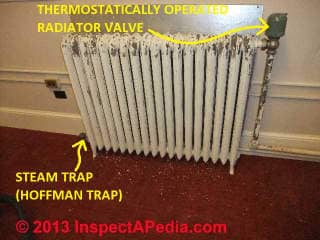 I had a question nigh the article at RADIATOR VALVES & HEAT CONTROLS.
I had a question nigh the article at RADIATOR VALVES & HEAT CONTROLS.
I'm looking at the sub-section "Types of Radiator Valves: Hot Water vs. Steam" ...
Photo at left: two pipage steam radiator fed from top right end. [Click to enlarge any image]
I was trying to make sense of what was written - it must be hard to draw these hot h2o and steam heating systems. In some cases it seems that in fact steam DOES often enter a radiator at the top.
At this point I am just lost. We don't accept many residential systems with radiator systems (steam or hot water) so I am trying to educate myself only don't accept anything in front end of me to compare what I think I understand.
Kind Regards, -Doug
Reply: Up-feed - Down-feed, One-pipe - Two-Pipe Steam Piping & Radiators - What'southward the Difference?
 Doug, the other page (not at InspectApedia) that you gave provides data from Dan Holihan - probably the nearly-expert young man alive when information technology comes to steam heating systems. Dan's text includes these 2 statements:
Doug, the other page (not at InspectApedia) that you gave provides data from Dan Holihan - probably the nearly-expert young man alive when information technology comes to steam heating systems. Dan's text includes these 2 statements:
Older steam radiators have nipples across just the bottom portion of the sections. This is because steam is lighter than air. When the steam enters the bottom of a radiator (as it always volition in a 1-piping steam radiator), information technology flows up into the sections, displacing the air as it goes.
Two-piping steam systems unremarkably have the steam entering through a pipage at the top of the radiator. [1]
Dan is right over again. Most 2-pipe steam heat systems volition show up with the steam entering the radiator at i end at the radiator superlative (below left), and the condensate return will exit at the lesser of the radiator at its contrary stop. [1][12][16][17]
All one pipe steam radiators are fed with a pipage connection to the bottom of the radiator.
In response to your question we take added an article to assist clarify the unlike types of steam heat piping - to - radiator connections and where valves volition occur.
Delight see STEAM RADIATOR PIPING CONNECTIONS for details of different types of steam piping and steam-radiator piping connections.
Matt
You can endeavour some Liquid Wrench or spray WD-40 lubricant to see if yous tin gratis a stuck radiator valve but
Watch out: don't forcefulness the valve handle as if yous break the valve and cause a leak y'all'll be faced with having to close your entire heating system down to wait for repair.
Cheers, that'south an interesting question about which valves work on which radiators that I'd non adquately considered.
It's certainly the case that some thermostatic radiator valves are described by the manufacturer as specifically for "hot h2o" i.e. hydronic not steam, heating systems.
E.g. The Danfoss ... TWA-actuator is used to electrically activate RA-2000, VMT, KOVM and RAV valves on hot water heating systems,
Just there are other thermostatic radiator valves like the Honeywell Braukmann V2042 HSL 10 that are specifically designed for 1-pipe steam heating systems. Described as
"Ane-Pipe Steam Thermostatic Radiator Valves - Allow automated temperature command in one-pipe steam or hot water systems for gratis standing radiators, convectors and other heating units with standard capacity requirements. Provide comfort and energy savings."
See these case instructions HONEYWELL BRAUKMANN V2040HSL10 INSTALLATION INSTRUCTIONS [PDF]
Conversely the Danfoss 013G8250 thermostatic radiator valve actuator is intended to work on hydronic or on two-pipe steam heating systems.
" RA 2000 Thermostatic Radiator Valves regulate the flow of hot water or low pressure steam through free-standing radiators, baseboards, or convectors in hot water and two-pipe steam systems. The Danfoss 013G8250 is the RA2000 Thermostatic Radiator Valve Operator with a valve mounted dial and a built-in sensor. The RA 2000 thermostatic operator consists of a saturated vapor charged bellows and a setting dial. The dial is set to the position equal to the desired temperature. When the ambient temperature lowers, the pressure level from the bellows will reduce, assuasive the valve to open.
A rise of temperature increases the pressure in the bellows closing the valve. The counterbalanced pressures between the adjustment leap and the bellows ensure a smooth and modulating operation of the valve. "
See these DANFOSS RA2000 RADIATOR VALVE INSTALLATION INSTRUCTIONS [PDF]
ii Questions:
i) You mentioned that one pipe steam systems should be set to fully open or fully airtight as having something partially open could damage the arrangement. I'm assuming that's why in single pipage steam systems you're reliant on adjustable air vents to control the heat of the radiator. Does that mean that the TRVs are only recommended for h2o or 2 piping systems as the function of the TRV is to partially open or close the valve?
ii) I have a i pipe steam radiator in a pocket-size area by the thermostat on the kickoff floor that I'd like to completely shut off. I'k assuming it being on is influencing how hot the second floor is getting (non quite every bit warm as the start floor).
The valve won't budge in either direction. Should/Tin can I spray some WD-40 on the valve stem to see if that loosens things upwards? If not, exercise you have an article on replacing just the valve stalk (if that's even possible)?
volition excessive heat crusade my radiator to leak
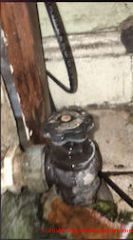 No, RK, heat lone would non explain a radiator valve leak.
No, RK, heat lone would non explain a radiator valve leak.
Radiator valve usually leak considering of this combination of factors
- age: gaskets go worn, dry, breakable
- corrosion: valves go stuck or difficult to plow
- debris: scale or rust collection can obstruct valve operating requiring it to be forced open or close
- surprises: draining a heating system, leaving water off, combined with cooling downwards and drying out that occur during that time, volition, in some valves or other plumbing devices, requite time for a valve stalk gasket already old and at the cease of its life, to dry and compress and then that when water, heat, and pressure are restored the valve leaks around the valve stem.
(Of course in that location are other potential leak points at connections but that's another give-and-take).
Sometimes with continued utilise, warmth, water contact, the stalk gasket will stop leaking;
Sometimes, with bang-up care, i can slightly tighten the bong packing nut and cease the valve stem leak.
Otherwise that part will need replacement.
Is the excessive heat which is controlled by building management the probable cause for my apartment radiator'due south broken valve and subsequent leak?
My flat steam radiator valve bankrupt later building management turned the water back on Tuesday and my apartment temperature increased from the 60'south to the 90'south Fahrenheit. The valve has been kept airtight for years.
Background
I live on the tiptop floor (v flooring) of a 150-year-old, NYC walk up building. My 500+ sq. ft. apartment has two steam radiators. The banality for my building and the adjacent building is under lock and key in the sub-basement.
On Tuesday (1/14/twenty), the water was turned off because of work done on the boiler and/or installation of a water vehicle onto well-nigh completed replaced roof. Normally my flat temperature is in the 60's. Since, my apartment is being overheated. On Thursday (1/16/20) at ane:11AM my apartment temperature was 98 degrees and at 4PM it was 89 degrees.
On early Friday (i/17/20) morning I learned that my downstairs neighbor had a leak. (I thought he was inquiring virtually a recent contentious allegation regarding my bathroom.) That evening at nine:15PM the apartment temperature was 93 degrees. This morning at v:30AM the temperature was 95 degrees.
Concluding night when the oestrus bordered on suffocating I realized that my valve was broken and water began flowing onto my apartment floor. The water menses has increased since. The valve has been turned off for years.
Dan
Check first that the boiler is upwardly to full operating temp (say 180F or more)
CHeck the pressure at the boiler - it ought to exist somewhere between xv and just under 30 psi.
With those confirmed, try bleeding the cold rads again - if y'all drain a cold rad without the system existence hot and up to pressure yous might accidentally depict air INTO the radiator; terminate bleeding when water appears at the bleeder.
If the rads are still cold then the organisation is airbound but the air is somewhere else, non in the radiator.
IN that instance see AIR-Jump HEATING SYSTEMS - https://inspectapedia.com/heat/Air_Bound_Heating_System.php
I tried to bleed my hot water radiators that were warm at the lesser but common cold at the top, and now they are getting no heat at all. Our radiators on the outset floor are working. Any ideas on what caused this or how I can ready it?
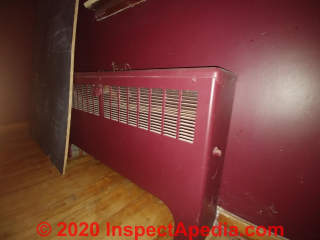 Greg
Greg
I have collected together our discussion of identifying the manual air bleeder on the side of your heating convector - now found at
RADIATOR VALVE & Oestrus Command FAQs - questions and answers posted originally on this folio.
https://inspectapedia.com/heat/Radiator_Valve_FAQs.php
Deplorable for the late reply: This is an imagse of one them. The other side is polish (aught on or in it).
Question: trouble decision-making level of steam heat - tin I close off the radiator
My building uses steam heaters. I have no control over the heat in my unit because the thermostat is controlled past my landlord/owner who lives higher up me.
Yet I have a small-scale 1 chamber with two heating units so even with all of the windows open up, it can still go very hot. Is it okay for me to completely close the "open/close" black knob valves on my units or will that cause problems for the whole system? My landlord had previously told me non to touch the valves... Emily 12/10/12
Reply:
Yep if the radiator command knob is not jammed or frozen y'all tin can try closing it partly or fully; radiator command knobs are intended to be a homeowner-resident-operator command. But if the knob is not piece of cake to turn, don't force information technology as you lot might cease up with a leak.
(Nov 7, 2022) Anonymous said:
Great articles here. Very informative.
(Jan 11, 2022) sharon said:
cheers for very articulate,detailed data.
...
Go along reading at AIR-Leap HEATING SYSTEMS or select a topic from the closely-related manufactures below, or see the complete ARTICLE INDEX.
Or see RADIATOR VALVE & Heat Command FAQs - questions and answers posted originally on this page.
Or see these
Recommended Articles
- AIR-BOUND HEATING SYSTEMS - habitation
- AIR BLEEDER VALVES - home
- CHECK VALVES, HEATING System - more than hot h2o & steam rut controls
- COLD HOT Water RADIATOR or BASEBOARD
- Cold STEAM HEAT RADIATORS
- RADIATOR VALVES & HEAT CONTROLS
- ADJUST LEVEL of Oestrus - How to Adjust or Control the Level of Heat From Radiators
- Automatic RADIATOR VALVES - Automatic or Thermostatically Controlled Radiator Valves
- RADIATOR CONTROL VALVES on CONVECTOR HEATERS
- RADIATOR VALVES Transmission - Which manner to turn the radiator valve
- RADIATOR VALVE STUCK or Cleaved REPAIR - how to repair or replace radiator valves
- RADIATOR VALVES HOT H2o vs STEAM - what's the divergence?
- STEAM HEAT VENT CHOICES & INSTALLATION - Adjustable or Thermostatically Controlled
- STEAM VENTS THERMOSTATICALLY CONTROLLED - Used to control steam radiators
- STEAM RADIATOR PIPING CONNECTIONS
Suggested citation for this web page
RADIATOR VALVES & Estrus CONTROLS at InspectApedia.com - online encyclopedia of building & environmental inspection, testing, diagnosis, repair, & trouble prevention advice.
Or see this
INDEX to RELATED Articles: ARTICLE Index to HEATING RADIATORS
Or use the SEARCH BOX found below to Ask a Question or Search InspectApedia
...
Ask a Question or Search InspectApedia
Questions & answers or comments about using, adjusting, & repairing radiator command valves and vents for both hot h2o and steam heat systems
Try the search box just beneath, or if you prefer, post a question or comment in the Comments box below and nosotros will respond promptly.
Search the InspectApedia website
Notation: appearance of your Comment below may exist delayed: if your annotate contains an image, spider web link, or text that looks to the software as if it might be a web link, your posting volition appear afterward it has been canonical by a moderator. Apologies for the delay.
Technical Reviewers & References
Click to Show or Hide Citations & References
Publisher InspectApedia.com - Daniel Friedman
Source: https://inspectapedia.com/heat/Radiator_Valves.php
Posted by: hofferwasioneating.blogspot.com


0 Response to "How To Repair F-150 Air Vent"
Post a Comment